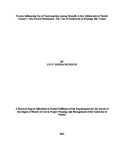| dc.description.abstract | This research sought to investigate factors influencing use of contraceptives among sexually
active adolescents in Nairobi County’s non formal settlements: the case of Majengo Sub-county.
The study sought to establish how: perception on use of contraceptives by adolescents,
adolescent’s sexual behavior, access to contraceptives and knowledge on contraceptives
influence the use of contraceptives among sexually active adolescents in Nairobi County’s non
formal settlements. The research was carried out on sexually active adolescents who had resided
in Majengo Sub County in Nairobi County for five years and more and were aged 12-19 at the
time of the study. Geographically, the research was delimited to the area bordering Pumwani
Hospital, Gikomba market, Majengo mosque, California estate and Moi air base. This research
was guided by two theoretical frameworks: The Diffusion of Innovations Theory by Everett
Rogers and The Reasoned Action Approach by Martin Fishbein and Icek Ajzen Martin. This was
a descriptive survey design research that applied the mixed mode approach to data collection.
The target population comprises 3000 adolescents and the sample size for the research was 353
which was calculated and obtained by use of Yamane formula. The participants in the study were
selected by proportionate quota sampling and the data was collected at household level. The
researcher therefore specified the minimum number of sample units in each quota to ensure
equitable representation between males and females and moved from house to house to collect
data. The data was collected by use of questionnaires. Pilot study was undertaken to ensure
validity and reliability of the data collection tool was calculated by use of Sphearman-Brown
Prophesy formula giving a reliability coefficient of 0.86. Some of ethical considerations made by
the researcher included informed consent, confidentiality and respect. The returned
questionnaires were sorted and data obtained organized by use of tallying method. A
questionnaire return rate of 96% was achieved. Microsoft Excel was used to calculate the
frequencies and the corresponding percentages; the coefficient of correlation (r) and the
coefficient of determination (r2) of the variables. Tables have been used to present the data where
frequencies and the corresponding percentages have been shown. The findings show that 110
(32%) of the respondents had consistently used contraceptives in the past six months while the
rest had used contraceptives at times, 168 (49%) or had not used any contraceptive in the same
time period. Further, the variables under study were found to influence the use of contraceptives.
The researcher recommends that more training be carried out to increase the levels of knowledge
on contraceptives and contraceptive use amongst the adolescents and hence enhance the
perception on teenage contraception, attributes of contraceptives that make them cumbersome to
use need to be addressed, awareness campaigns be carried out in the general society to destigmatize
the use of contraceptives by adolescents and affirmative action be decided upon to
cushion adolescents on high cost of contraceptives. | en_US |

